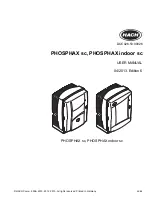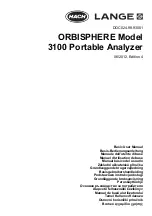
<12. Troubleshooting>
12-5
IM 11M12A01-04E
11th Edition : Jul. 19, 2017-00
l
Alarm 6: Zero Calibration Coefficient Alarm
In calibration, this alarm is generated when the zero correction ratio is out of the range of 100 ±
30% (refer to Section 9.1.4, “Compensation”). The following can be considered the causes for
this:
(1) The zero gas oxygen concentration does not agree with the value of the zero gas
concentration set (refer to Section 9.2,“Calibration Procedures.)” Otherwise, the span gas is
used as the zero gas.
(2) The zero gas flow is out of the specified flow (600 ± 60 ml/min).
(3) The sensor assembly is damaged and so cell voltage is not normal.
<Search for cause of failure and Take measures>
(1) Confirm the following and carry out calibration again: If the items are not within their proper
states, correct them.
a. If the indication for “Zero gas conc.” is selected in “Calibration setup,” the set value should
agree with the concentration of zero gas actually used.
b. The calibration gas tubing should be constructed so that the zero gas does not leak.
(2) If no alarm is generated as a result of carrying out re-calibration, it is suspected that
improper calibration conditions were the cause of the alarm in the preceding calibration. In
this case, no specific restoration is necessary.
(3) If an alarm is generated again as a result of carrying out re-calibration, deterioration of or
damage to the cell (sensor) is suspected as the cause of the alarm. Replacement of the cell
(sensor) with a new one is necessary. However, before replacement, carry out the following:
Check the cell voltages when passing the zero gas and span gas.
a. Display the cell voltage with the parameter code A11.
b. Check whether or not the value of the displayed cell voltage is very different from the
theoretical value at each oxygen concentration. Confirm the theoretical values of the
cell voltage in Table 12.3. Although it cannot be generally specified as to what extent the
difference from the theoretical value is allowed, consider it to be approximately ±10 mV.
Table 12.3
Oxygen Concentration and Cell Voltage Oxygen concentration
Oxygen concentration (% O
2
)
Cell voltage (mV)
1%
67.1
21%
0
(4) Confirm whether deterioration of or damage to the sensor assembly that caused the alarm
has occurred abruptly during the current calibration in the following procedure:
Check the history of the span gas correction ratio with the parameter codes A50 through
A59, Check the history of the zero gas correction ratio with the parameter codes A60
through A69. The larger the parameter code number, the older the displayed data. Changes
in deterioration of the sensor can be seen.
(5) If deterioration of the cell assembly has occurred abruptly, it may show that the check valve,
which prevents moisture in the furnace from getting into the calibration gas tubing, has
failed. If the gas in the furnace gets into the calibration gas tubing, it condenses and remains
in the gas tubing. The cell assembly is considered to be broken for the reason that the
condensation is blown into the cell assembly by the calibration gas during calibration and so
the cell cools quickly.
(6) If the cell assembly has been gradually deteriorating, check the cell assembly status in the
following procedure:
a. Display “Cell resistance” by specifying the parameter code A21. A new cell will show
a cell resistance value of 200Ω or less. On the other hand, a cell (sensor) that is
approaching the end of its service life will show a resistance value of 3 to 10 kΩ.
b. Display “Cell robustness” by specifying the parameter code A22. A good cell (sensor) will
show “5,” “Life > 1 year” (refer to Section 10.1.17).
Summary of Contents for EXAxt ZR402G
Page 9: ...Blank Page...
Page 51: ...Blank Page...
Page 151: ...Blank Page...
Page 165: ......
Page 167: ......














































